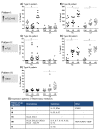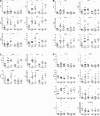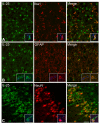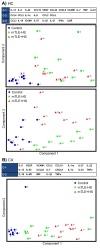Protein expression profiling of inflammatory mediators in human temporal lobe epilepsy reveals co-activation of multiple chemokines and cytokines
- PMID: 22935090
- PMCID: PMC3489559
- DOI: 10.1186/1742-2094-9-207
Protein expression profiling of inflammatory mediators in human temporal lobe epilepsy reveals co-activation of multiple chemokines and cytokines
Abstract
Mesial temporal lobe epilepsy (mTLE) is a chronic and often treatment-refractory brain disorder characterized by recurrent seizures originating from the hippocampus. The pathogenic mechanisms underlying mTLE remain largely unknown. Recent clinical and experimental evidence supports a role of various inflammatory mediators in mTLE. Here, we performed protein expression profiling of 40 inflammatory mediators in surgical resection material from mTLE patients with and without hippocampal sclerosis, and autopsy controls using a multiplex bead-based immunoassay. In mTLE patients we identified 21 upregulated inflammatory mediators, including 10 cytokines and 7 chemokines. Many of these upregulated mediators have not previously been implicated in mTLE (for example, CCL22, IL-7 and IL-25). Comparing the three patient groups, two main hippocampal expression patterns could be distinguished, pattern I (for example, IL-10 and IL-25) showing increased expression in mTLE + HS patients compared to mTLE-HS and controls, and pattern II (for example, CCL4 and IL-7) showing increased expression in both mTLE groups compared to controls. Upregulation of a subset of inflammatory mediators (for example, IL-25 and IL-7) could not only be detected in the hippocampus of mTLE patients, but also in the neocortex. Principle component analysis was used to cluster the inflammatory mediators into several components. Follow-up analyses of the identified components revealed that the three patient groups could be discriminated based on their unique expression profiles. Immunocytochemistry showed that IL-25 IR (pattern I) and CCL4 IR (pattern II) were localized in astrocytes and microglia, whereas IL-25 IR was also detected in neurons. Our data shows co-activation of multiple inflammatory mediators in hippocampus and neocortex of mTLE patients, indicating activation of multiple pro- and anti-epileptogenic immune pathways in this disease.
Figures







References
-
- Leonardi M, Ustun TB. The global burden of epilepsy. Epilepsia. 2002;43(Suppl 6):21–25. - PubMed
-
- Kwan P, Brodie MJ. Clinical trials of antiepileptic medications in newly diagnosed patients with epilepsy. Neurology. 2003;60:S2–S12. - PubMed
-
- Cascino GD. When drugs and surgery don’t work. Epilepsia. 2008;49(Suppl 9):79–84. - PubMed
-
- Proper EA, Oestreicher AB, Jansen GH, Veelen CW, van Rijen PC, Gispen WH, de Graan PN. Immunohistochemical characterization of mossy fibre sprouting in the hippocampus of patients with pharmaco-resistant temporal lobe epilepsy. Brain. 2000;123(Pt 1):19–30. - PubMed
Publication types
MeSH terms
Substances
LinkOut - more resources
Full Text Sources
Medical

